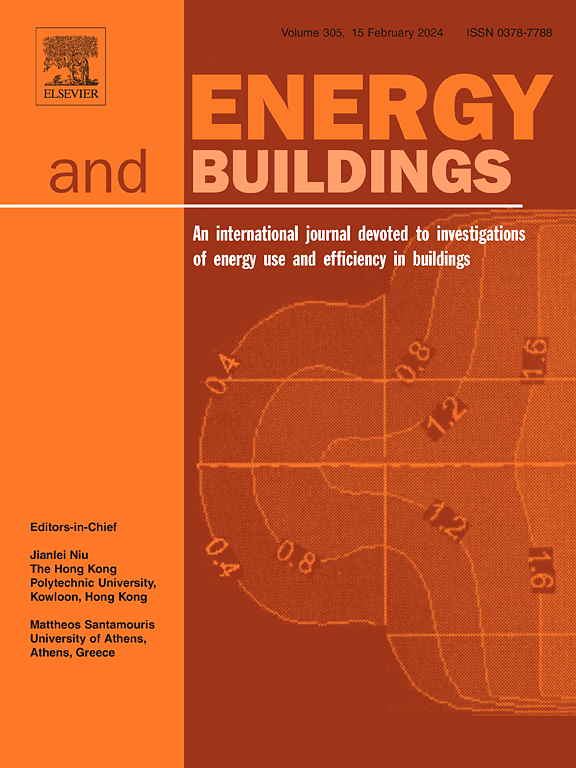光伏发电和燃气热电联产多户住宅的能源模拟验证:平衡能源效率和居民健康的案例研究
IF 6.6
2区 工程技术
Q1 CONSTRUCTION & BUILDING TECHNOLOGY
引用次数: 0
摘要
在日本,住宅部门的能源消耗非常高。因此,隔热改造和行为改变已成为提高能源效率的关键。虽然有几项研究考察了这些因素,但它们都集中在标准住宅单位和普遍的生活方式上。本研究通过模拟研究了一个实际的零能耗住宅(ZEH)认证住宅的隔热性能和生活方式对能源消耗、健康和经济效率的影响,该住宅安装了光伏板和固体氧化物燃料电池的双发电系统。利用2024年冬季的能耗和室内温度数据对仿真模型进行了验证;居民访谈也被纳入反映他们的行为。结果表明,一次能耗超过ZEH设计值,主要是由于照明和燃气消耗高于预期。在无人居住的房间里使用照明,并且经常使用热水。每天仅运行地板供暖系统约3小时,就足以使室内温度维持在世卫组织建议的冬季最低温度18°C以上。关于建筑围护结构的性能,居民的早晨血压估计为127.5 mmHg;然而,较低的保温性能导致血压升高至137.6 mmHg,超过135 mmHg的阈值,表明潜在的健康风险。行为优化,如控制不必要的照明、高效电器和热水系统的使用,在不损害健康的情况下,减少了15%的能源消耗,提高了33%的经济效率。此外,即使在24小时地暖运行时,这些行为优化也有助于减少11%的能耗,提高25%的经济效率。本文章由计算机程序翻译,如有差异,请以英文原文为准。
Validation of energy simulations for multi-family residences with photovoltaic power and gas cogeneration: Case study on balancing energy efficiency and resident health
In Japan, the energy consumption of the residential sector is significantly high. Therefore, insulation retrofitting and behavioral changes have become critical to enhance energy efficiency. Although several studies have examined these factors, they have focused on standard dwelling units and generalized lifestyle patterns.
This study investigated, through simulations, the impacts of thermal insulation performance and lifestyle behavior on energy consumption, health, and economic efficiency of an actual Zero Energy House (ZEH)-certified dwelling installed with a dual-generation system combining photovoltaic panels and a solid oxide fuel cell. The simulation model was validated using energy consumption and indoor temperature data from the winter of 2024; resident interviews were also incorporated to reflect their behavior.
Results showed that the primary energy consumption exceeded the ZEH design values, mainly owing to higher-than-expected lighting and gas consumption. Lighting was used in unoccupied rooms, and water heating was frequently used. Operating floor heating systems for only approximately 3 h per day was sufficient to maintain indoor temperatures above 18 °C, the WHO-recommended minimum in winter. Regarding the building envelope performance, residents’ morning blood pressure was estimated at 127.5 mmHg; however, a lower thermal insulation performance resulted in an increase in blood pressure to 137.6 mmHg, exceeding the 135 mmHg threshold, indicating potential health risks.
Behavioral optimizations, such as controlling the use of unnecessary lighting, high-efficiency appliances, and water heating systems, reduce energy consumption by 15% and improved economic efficiency by 33%, without compromising health. Moreover, even when operating 24-hr floor heating, these behavioral optimizations contribute toward reducing energy consumption by 11% and improving economic efficiency by 25%.
求助全文
通过发布文献求助,成功后即可免费获取论文全文。
去求助
来源期刊

Energy and Buildings
工程技术-工程:土木
CiteScore
12.70
自引率
11.90%
发文量
863
审稿时长
38 days
期刊介绍:
An international journal devoted to investigations of energy use and efficiency in buildings
Energy and Buildings is an international journal publishing articles with explicit links to energy use in buildings. The aim is to present new research results, and new proven practice aimed at reducing the energy needs of a building and improving indoor environment quality.
 求助内容:
求助内容: 应助结果提醒方式:
应助结果提醒方式:


